Corporate / Business Portrait Photography Tips
Formal portraits are often used by businesses for photos of staff and executives on their website or brochures such as annual reports. The portraits are usually taken in a studio or at the business premises, but either way it is usually important that the portraits give a professional appearance.
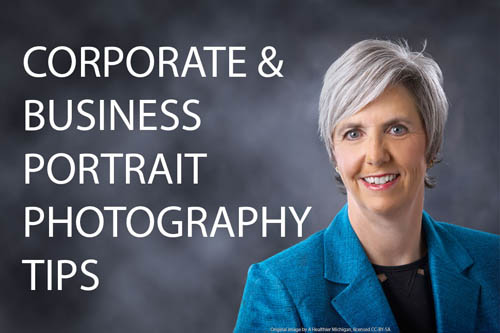
Image based on Linda Jones by A Healthier Michigan (licensed CC-BY-SA)
Make sure you speak to the client before the shoot to get a good idea of what sort of portrait they are looking for - full body or head shot? Studio shot or environmental portrait? Do they have a specific shooting location in mind? etc. etc. This will help you plan the shoot before hand, so you can make sure you bring the equipment you will need, and won't be hit with any surprises.
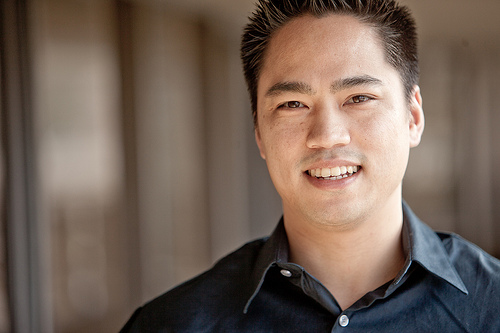
Untitled by kris krüg on flickr (licensed CC-BY-SA)
You don't need a lot of equipment to take a business portrait, just a light source and suitable background.
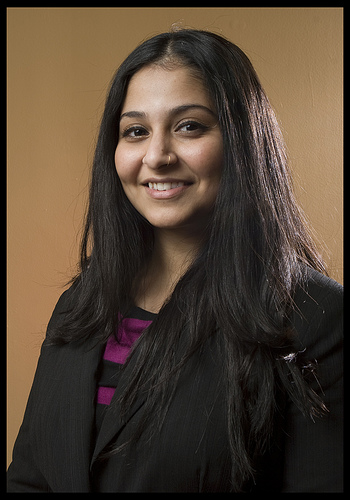
Headshot by Rahul Deshpande on flickr (licensed CC-BY-ND)
Lighting
For the light source, natural light from a window may be sufficient, but generally a couple of flash units or lamps would be preferred, to give you more control over the lighting.
When lighting business portraits, try to light the face so that one side is lit more brightly than the other. This brings some definition to the face, and prevents it from looking flat. A light at an angle to one side of the face, with a reflector to act as fill light on the other side of the face works well.
You will probably want a couple of lightstands to mount the lights on, and some diffusers, such as an umbrella or softbox as well.
If you are dealing with a busy executive or business owner, you may want to get someone else to stand in for the executive while you take a few test shots and adjust the lights accordingly for the wanted result.
Make sure you adjust your white balance to match that of the lights you are using, e.g. use tungsten white balance if you are using tungsten hot lights, or use flash white balance if you are using flash units.

Master Lighting Guide for Portrait Photographers
If the subject has a lot of wrinkles, try softening the light to reduce the contrast on the face. Either use a larger light source / reflector / diffuser, or bring your existing light source nearer to the subject, thus increasing the apparent light size. This will give a much softer, more diffused light and reduce harsh shadows.
Background
When shooting on location, most businesses have plain walls that will make a suitable background for a formal portrait. You can also purchase a background stand and background (either cloth or rolled card/paper) that can be setup to provide a nice clean background wherever the portrait is taken.
Executives or business owners may want their photo taken in their office. In this case you may need to do a little tidying, such as clearing away papers from the desk etc to remove any un-needed distractions. Obviously, check with the client before moving things around!
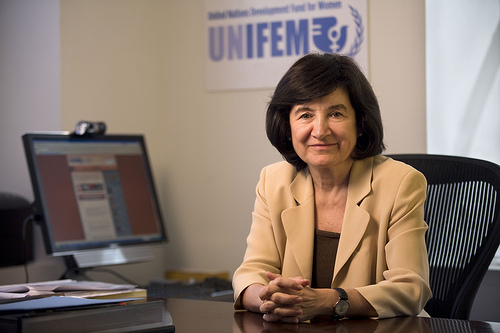
Inés Alberdi, Official Portrait, no. 1 by United Nations Development... on flickr (licensed CC-BY-ND)
Focus
Just as in virtually any other form of portraiture, the critical focus should be on the eyes of the subject. As humans we are instinctively drawn to look at the eyes of a portrait, and so it is very important the eyes are in focus.

Jim Larrison - Headshot 2011 by Jim Larrison on flickr (licensed CC-BY)
If you are using a very shallow depth of field, and the subject has their head at an angle, then make sure that the eye nearest the camera is where the plane of critical focus is placed.
The aperture you should use when taking a business portrait photograph should depend on the client's preference. Check beforehand with the client what sort of look they are wanting. For a soft look go with a large aperture such as f/2.
Or to get all of the person and most of the background in focus, use a smaller aperture such as f/8 or f/11. This is generally the preferred look for formal business portraits. Remember that the depth of field will vary depending on how close you are to your subject combined with the focal length of the lens you are using.

The Hot Shoe Diaries: Big Light from Small Flashes
Posing
Posing is something that should be discussed with the client beforehand, in case they are looking for a particular pose. In general though, formal business portraits will be either:
- Sitting, with the hands together in the lap, or if sitting at a desk, hands together on the desk, leaning forward on the desk slightly.
- Standing, with hands together at the waist, or hands in jacket / trouser pockets.
You don't necessarily need to include the hands in the shot, but posing like this can produce a more natural and relaxed look.
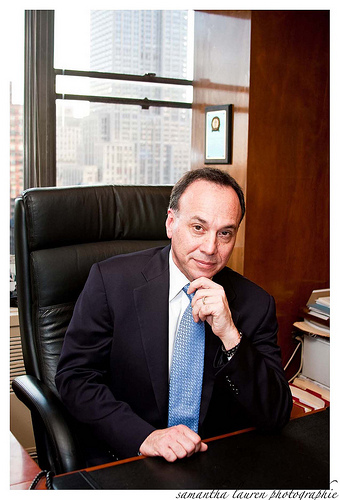
IMG_7716sm by Samantha Lauren Photographie on flickr (licensed CC-BY)
If the person you are photographing wears eyeglasses, try and avoid any reflections from the lights in the glasses. If there are reflections, try adjusting the height and/or position of the lights, so as to change the angle of the light.
If the subject has a large nose, you can try and minimize this by having them look directly at the camera, with their their chin slightly raised. Conversely, a small nose can be given more significance if the subject has their head at more of an angle to the camera.
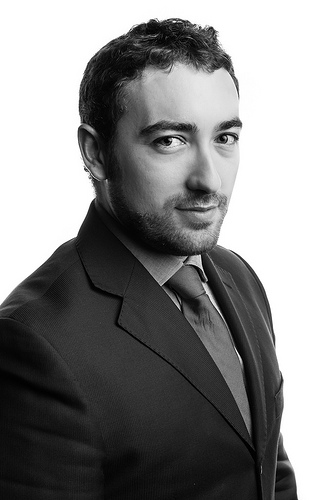
Luca Sartoni by Luca Sartoni on flickr (licensed CC-BY-SA)
Engage the subject in conversation, try to get them to relax - maybe tell a few jokes. Take a few photos, and make sure you have one that's in focus, exposed properly, and where the subject's expression looks natural rather than forced, before you end the session.




